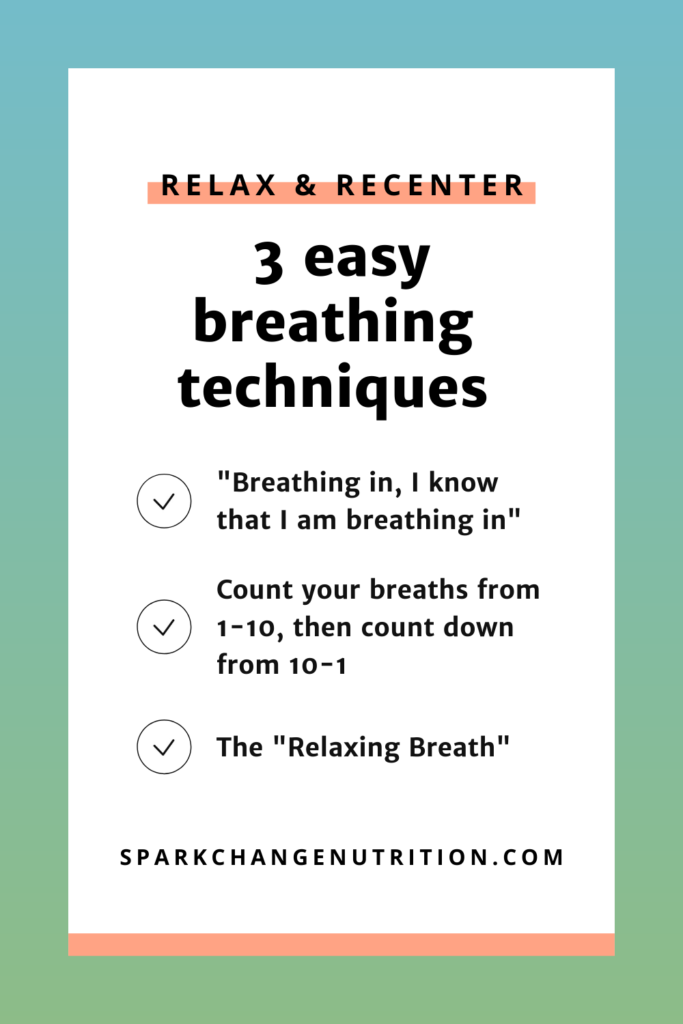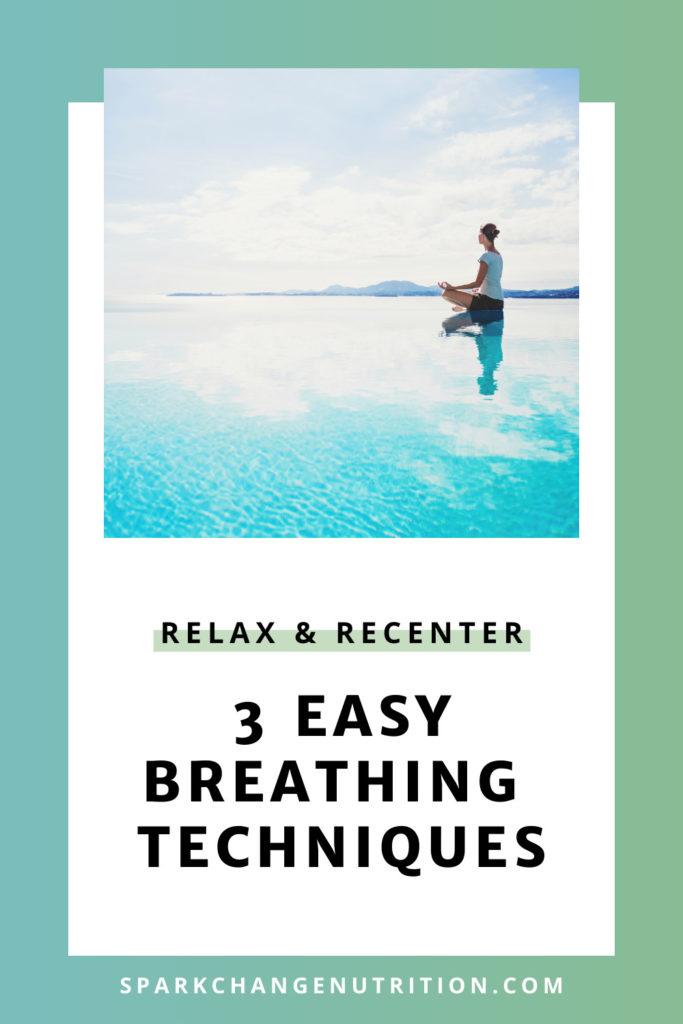Have you ever felt overwhelmed or distracted and needed a way to quickly calm down and recenter? This post will walk you through three of my favorite breathing techniques to help you do that, and it will explain how they tie into a mindful eating practice.

My youngest started preschool this year, and he is going for about 2 1/2 hours a day five days per week. This is a boon for me – I finally have time for myself! I finally have time to work on my business and this blog!
But do I, really?
Because I also need to use this time to catch-up on all the things I couldn’t do for the last year-and-a-half during the pandemic, when he was home with me full-time and we were stuck in the house. I love my family, and I am grateful that I was homebound with them during Covid. But I also had no alone time. For a year-and-a-half. So I really want to be wise about how I use the time when my son is at school.
Being a bit neurotic by nature, this is often what happens: I drop my son off at school, start working on something, and then feel guilty about the other things that I am not doing during that time. (Maybe you can relate to this??) It is frustrating, and self-defeating. And it is also super hard to concentrate and be productive when you are constantly second-guessing your choices.
Fortunately, there is a way around this. It’s called mindfulness.
How this type of mindfulness works in practice
Being schooled in meditation and mindfulness, here is how I recommend approaching this type of situation:
- Decide, with a wise mind,* which choice is best/which thing you want to work on
- Use mindfulness to get and stay engaged with that choice
- When your mind wanders to guilt over not doing the other thing(s), you non-judgmentally observe that, and then gently guide it back to the task at hand
Do this often enough, and you will be able to focus in the present moment.
How to get mindful, quickly: the three breathing techniques
Okay, so I just told you to “use mindfulness to get and stay engaged with that choice.” But what does that mean?
If you are already familiar with mindfulness and have some techniques already under your belt, perfect, use one of those. If you are new to mindfulness or need ideas for quickly returning to the present, here are three really easy techniques I’ve used over the years to help me take a mini-mindfulness break:
1. “Breathing in, I know that I am breathing in . . .”
I adopted this one after reading a book by Thich Nhat Hanh, a Vietnamese Buddhist Zen Master and meditation teacher. It’s super simple; you just pay attention to each breath. On the inhale you say to yourself “breathing in, I know that I am breathing in.” Then on your exhale you say “breathing out, I know that I am breathing out.” Repeat this for several breaths.
2. Counting to 10, then counting back down to one
This one I learned about in the book Beginning Mindfulness: Learning the Way of Awareness by Andrew Weiss. Again, it’s super easy to do. You just count each breath until you get to the number 10. Once you reach the number 10, you count your breaths again in reverse until you get to the number one. You can repeat this as many times as you need to to feel centered and calm.
3. The “relaxing breath” by Dr. Andrew Weil
I really like this one when I am feeling a little keyed up and need to relax. Instead of counting your breath, you make each portion of your breath last for a certain amount of time. Dr. Weil recommends the ratio of 4-7-8, which looks like this:
- After exhaling through your mouth, breathe in through your nose for a count of 4
- Hold your breath for a count of 7
- Exhale slowly through your mouth for a count of 8
It takes a little practice to get the timing on this right; you don’t want to exhale too quickly and end up having to gulp air on your next inhale. But once you figure it out, this breathing technique is an excellent one to have in your toolbox.
You can watch a video tutorial of how to do this breath on Dr. Weil’s website. You can also purchase a copy of the audio from one of my favorite websites for finding this kind of content: Sounds True.
How these breathing techniques relate to mindful eating
What does all of the above have to do with eating? The way these techniques relate is that these practices (or really any mindfulness practice) can be used before beginning or even during a meal. They will help you to quickly become present and centered, which is one of the foundations of mindful eating.
If you practice them before eating, you will also get better at using them when you are distracted or stressed in regular life. And if you practice them when you are distracted and stressed, you will get better at using them (and remembering to use them) before eating. It’s a mutually reinforcing cycle.
Action item: practice a breathing technique
Now I’m going to give you a quick homework assignment. Pick one of the three breathing techniques I just mentioned and give it a try, right now. It doesn’t have to be for very long; even one minute is a good start.
If you’re feeling ambitious, or you’ve got some time on your hands, you can try all three. Pick one that feels the most helpful to you, and try to do it once a day for the next several days.
Want to learn more about mindful eating?
Check out my post on starting a mindful eating practice.
Notes
*Wise mind is a concept found in Dialectical Behavior Therapy (DBT), a type of therapy created by Marsha Linehan.






0 Comments